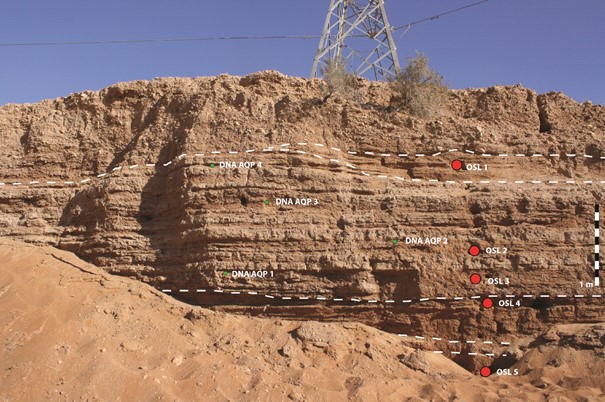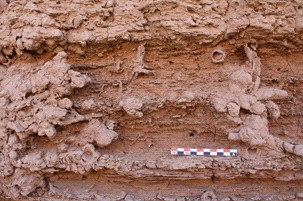Award Holder: Kira Dähling
University: Oxford Brookes University
Title of Research: Palaeoenvironment reconstruction of Southeast Arabia to investigate the dispersal of modern humans out of Africa
This project aims to investigate climatic and landscape changes from an exposed stratified sequence of fluvial gravels, silts and sands close to the important archaeological site Faya (dated human occupation stretching 130 ka – 10 ka) (Armitage et al. 2011, Bretzke et al. 2013) in the United Arabic Emirates (N25°02.569′ E055°48.166′). The investigation of the palaeoenvironment will provide new insides into the possibilities of modern human dispersals out of Africa. For the first time environmental DNA (eDNA) samples were analysed with the intention to integrate the results together with optical stimulated luminescence (OSL) dating into the palaeoenvironmental record in Arabia (Pedersen et al. 2015). Previous investigations at Jebel Aqabah already interpreted alternating silt and sand layers as phases of lake formation around 60 ka (Parton et al. 2010). This has to be seen with caution due to fact that short-lived precipitation events can also deposit silt layers. Therefore eDNA, which derives from numerous organisms such as microbes, plants and vertebrates and binds to minerals in the sediment (Willerslev et al. 2003, 2014, Rawlence et al. 2014, Pedersen et al. 2015, Hofreiter et al. 2012, Houldcroft et al. 2017) can help to differentiate between a short-lived precipitation event or a prolonged wet phase.
Fieldwork was carried out in March 2018 at the site Aqabah Pylon near Jebel Aqabah and identified a ~5 m sequence of fluvial deposits, indicative of drainage activation in the region during a previous humid period (Fig. 1).

The selected sequence shows clear evidence for past vegetation (Fig. 2). Numerous desiccation cracks at the top of several silt layers demonstrate alterations of wetter and dryer conditions. (Fig. 3).


During fieldwork, the section was logged and recorded in detail, with sediment samples extracted for palaeoenvironmental analyses, tube samples extracted for dating by optically stimulated luminescence (OSL) and eDNA samples extracted in small DNA free tubes.
The laboratory work to investigate the eDNA was carried out with the support of Dr. Christiana Lyn Scheib from 22 April to 02 May 2019 at the Institute of Genomics, Tartu University, Estonia. While no eDNA was recovered from this section I was able to work on samples taken from the nearby Jebel Faya rock shelter and the results do look promising and form the basis of a presentation for the ESHE 2019 conference in Liege, Sept 2019.
